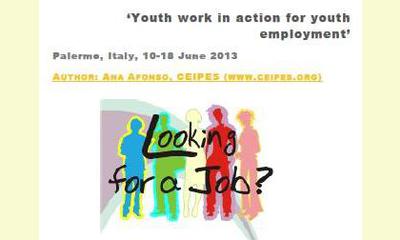|
|
Youth work in action for youth employment in Europe
un article par Ana Afonso
The training course ‘Youth work in action for
youth employment’ (which was granted Youth in
Action financial support) took place from the 10th
until the 18th July in Palermo, Ballarò. It
convened 34 youth workers from nearly 15 European,
Eastern European and Caucasian countries. The main
goal that brought together this group was to learn
new information about youth (un)employment in the
countries present into the meeting and, moreover,
to acquire new tools on the subject of youth
employability.

click on photo to enlarge
The training course was inspired in the booklet
‘Inclusion through employability’ (developed by
SALTO Inclusion Resource Centre) and it primarily
focused in three subject areas: involvement and
participation of young people, non-formal learning
and entrepreneurship.
The first dimension, involvement and participation
of young people, was addressed through group
discussions and reflection on the stereotypes and
prejudices society holds towards young people.
The second theme, non-formal learning, highlighted
the value of non-formal education in the
development of the soft-skills required by almost
all job positions. Namely the intercultural
competence, cooperation and problem solving
skills, autonomy and language competences, and
many others. Participants’ contributions were the
main sources of learning and they highlighted the
role of learning mobility, the importance of civic
engagement to networking and finding a job, the
need for self-awareness and self-esteem in job
search, the relevance of entrepreneurship
competence to be stimulated since an early age.
Lastly, the entrepreneurship dimension was
addressed in less depth given the focus of the
training being more on other aspects of youth
employability. Although the group develop
campaigns to motivate young people to becoming
entrepreneurs and there was a reflection on social
entrepreneurship.
The most remarkable moments of the training were
the community mapping activity, that proved to be
an essential tool in the framework of youth
employability; the work on employment and human
rights that brought into discussion aspects
related with discrimination and exploitation of
young people and other vulnerable groups; and the
group discussions most useful to underlying the
prejudices and stereotypes society holds and
participants themselves too.
The main project outcome was an employability tool
designed to facilitate the development of youth
strategic employability plans. The tool has a two
fold practical use; the first is to facilitating
youth workers’ development of concrete and
feasible strategic plans that may boost youth
employability in specific areas or communities.
The second is to contributing to trainers’ work in
the field with groups of youth workers engaged in
youth employability activities. The tool is
downloadable for free in this link: http://www.ceipes.org/?p=2728
|








|
DISCUSSION
Question(s) liée(s) à cet article:
Is there a renewed movement of solidarity by the new generation?,
* * * * *
Commentaire le plus récent:
from Javier Collado Ruano, Director of Edition at Global Education Magazine, on the occasion of the International Day of Solidarity.
Solidarity is a trans-dimensional phenomenon that goes beyond the ontological essence of human nature. In fact, when we analyze the connections between the microcosm and the macrocosm, we perceive that human beings are not involved in chaos and arbitrariness, but belongs to the large network of interdependencies, complementarities and reciprocities that constitute life. The emergence of life on Earth, around 3,8 billion years ago, was a complex process of exceptional natural phenomena, inherent in all living systems. A process which is expressed through unlimited creativity: mutation, gene exchange, and symbiosis. From a cosmo-biological perspective, we can understand a new conceptual dimension of life, where all living beings share same basis of genetic code: the twenty amino-acids and four phosphatic bases. In fact, the diversity of living beings is caused by the combination of this cosmo-bio-genetic basis.
This trans-dimensional perspective has a deep ecological and spiritual sense for our worldview because the human evolutionary adventure is the latest stage of life on Earth. The modern human being is a vertebrate animal, mammal, belonging to the primates, which emerged 200,000 years ago. In recent centuries he has imposed its anthropocentric, industrial and capitalist vision to the detriment of Pachamama (and Indigenous goddess known as earth mother). We consume around 120% of the natural resources that Earth Mother regenerats annually. Our consumer behavior is immersed in a fatalistic dynamic with a destiny to climate change (deforestation, loss of biodiversity, ozone, etc.), and our own self-destruction as a species.
There is an urgent need to get beyond the cognitive fallacy that the mental structures of social Darwinism and capitalist postulates of the 19th century have historically constituted, because they only understand natural and social systems as warmongers and competitive processes whereby species diverge from each other. . ... continuation.

|
|









